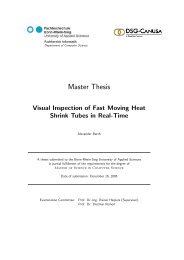Master Thesis - Hochschule Bonn-Rhein-Sieg
Master Thesis - Hochschule Bonn-Rhein-Sieg
Master Thesis - Hochschule Bonn-Rhein-Sieg
Create successful ePaper yourself
Turn your PDF publications into a flip-book with our unique Google optimized e-Paper software.
6. Evaluating the safety <strong>Master</strong> <strong>Thesis</strong> Björn Ostermann page 108 of 126<br />
“Soft limits are software-defined spaces that define the restricted space where the robot is<br />
inhibited from exiting or entering while in automatic mode or any mode using speeds above<br />
reduced speed. […] Motion may be restricted to keep the robot inside the defined space or to<br />
prevent the robot from entering or accessing the defined excluded space.<br />
[…]<br />
A safety-rated soft limit shall be set as a stationary zone that cannot be changed without a<br />
system power up condition and shall not be changed dynamically. […]” [70]<br />
� 5.12.4 Dynamic limiting devices<br />
“Dynamic limiting is the automatically controlled change in a robot’s restricted space during a<br />
portion of the robot system’s cycle. Control devices such as, but not limited to, cam operated<br />
limit switches, light curtains [...] may be utilized to further limit robot movement within the<br />
restricted space while the robot performs its task programme provided the device and<br />
associated controls are capable of stopping the robot motion under rated load and speed<br />
conditions and the associated safety controls comply with category 3 of ISO 13849-1, unless a<br />
risk assessment is performed and determines that another category is required.” [70]<br />
While the standard allows “dynamic limiting devices”, such as the flexible fence, it forbids the<br />
inclusion of this fence in the safety concept of the used robots safety trips (see chapter 3.1), since it<br />
demands for the robot’s control to be rebooted for every change.<br />
The connection of safety trips and developed approach is not yet realized, but in order to achieve the<br />
category 3, as requested by this standard and the EN 13849-1 as well (see chapter 6.2.3), this would be<br />
an advantageous step in the future.<br />
The standard therefore can be applied only in parts. Future developments in the field of collaborative<br />
workplaces, “flexible fences” becoming state of the art, will possibly lead to changes in this standard.<br />
6.3 Achieved safety<br />
To estimate the achieved safety of the workplace, the system was tested on its performance. From this<br />
performance the necessary safety distance of the system is calculated in this chapter. During the course<br />
of this chapter the used equipment is treated as if it were safe, knowing well that this is not the case.<br />
All tests were performed on an Intel Core 2 Duo E8200 (2.66 GHz), equipped with 2 GB of RAM,<br />
running WinXP SP2. The developed program was executed in the debug mode of Visual Studio 2008<br />
Version 9.0.30729.1 SP, in order to acquire the different runtimes.<br />
The additional computational overhead of the debug mode has only minor influences in the complete<br />
runtime, since the largest amount of time is used for communication between camera, PC and robot’s<br />
PLC.<br />
The error in measurement is too low to have a visible influence and was thus omitted in this chapter. If<br />
the presented calculations would not be done to show a measurement of the achieved results of this<br />
thesis and the constructed demonstrator, but to calculate the performance of such a system in industrial<br />
praxis, an additional error calculation would be necessary.<br />
Due to the necessary accuracy of the camera, used in the workplace, only 10 frames per second (FPS)<br />
could be delivered by the camera. The camera is able to deliver more frames per second, but when it














